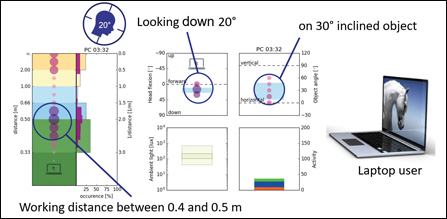Wearable sensor system may help surgeons obtain individual vision-related behavior
This new technology provides measurements and data on real-life use of vision.
A simple, wearable sensor system engineered by IROC Science in Zurich, Switzerland, provides real-life measurable data on patients’ use of vision and objective criteria to select IOLs, inlays and progressive spectacles.
“We have very sophisticated solutions today for IOLs and other refractive implants, but not an equally sophisticated technology to assess what a patient needs. This is only assessed in a short interview, with no scientific evidence of vision-related behavior,” Arthur Cummings, MD, said.
The Vision Behaviour Monitor (VBM) consists of a low-energy Bluetooth interface with sensors measuring distance, ambient light and color, an accelerometer, a gyroscope and a magnetometer. It is worn on prescription or clear glasses and non-obtrusively tracks viewing distance, activity, ambient light and other context parameters. Measurements are monitored and recorded on a paired wrist-worn smartwatch or smartphone. The device does not include a camera and is therefore non-intrusive and protects privacy.

“Patients can wear it for a few days, turning it on and off to take records of the activities that are more commonly performed in their daily life and reflect their actual visual needs,” Cummings said.
Plotting data
Measurements can be mapped on two-dimensional distribution of viewing distances and are further translated into refractive distribution.
“When you see the data translated into a diagram of refraction distribution, it gives you an idea of where a patient spends most of his or her time and doing what. The most interesting is then to see the statistics, which relate distances to the refraction effort and the time spent at the respective distances. These statistics can be daily, total (averaged over multiple days) or activity-related,” Cummings said.

Images: Cummings A


Sensors also provide and combine multiple signals, such as motion activity, head flexion, ambient light intensity and color. This kind of monitoring allows better understanding of the context of vision activities — not only what the user is doing, but also where and how.
“In this particular case [Figure 1], we see that the patient works long hours on a computer screen, so most of the time is spent in the range of –0.5 D to –2 D. This activity plot shows movement of the head along three axes. And the ambient light during driving, watching TV, being at a meeting, having a meal is also documented,” Cummings said.
Tests show high diversity
The device was tested in a study of nine users, six men and three women. They were asked to wear the VBM during important visual activities at home, in the office or outdoors. Users could decide which activities were important for them and could start and stop the device accordingly, clicking on specific activity icons or writing a free text.
Looking at the individual profiles, for the majority of users a computer-related peak was clearly indicated. For some there was a significant contribution of meeting/teaching or outdoor exercise activities. For two there was a pronounced contribution of reading, desk and smartphone activities.
“The patterns of these nine users looked so different [Figure 2]. And bear in mind that we may potentially provide the same solution for these patients, the same trifocal or extended depth of focus IOL,” Cummings said.
It emerged from the analysis of these profiles how misleading interviews can be. Two people reporting PC-related activities had markedly different patterns. One of them was looking forward to a vertical surface directly in front (Figure 1). The other one was looking down 20° at a distance of 40 cm to 50 cm to a 30° inclined object (Figure 3).
“We could derive that user 1 is primarily a desktop PC user and user 2 is a laptop user. The key message here is that self-reported activities are not sufficient to describe individual vision behavior. We need real measurements in the patient’s world, whether it be at home or at work, in order to make the best decisions on their visual behavior and needs, therefore the VBM,” Cummings said. – by Michela Cimberle
- For more information:
- Arthur Cummings, MD, is consultant eye surgeon at the Wellington Eye Clinic and consultant ophthalmologist and head of the department of ophthalmology at Beacon Hospital, Dublin, Ireland. He can be reached at email: abc@wellingtoneyeclinic.com.
Disclosure: Cummings reports no relevant financial disclosures at the time of publication of this article.

